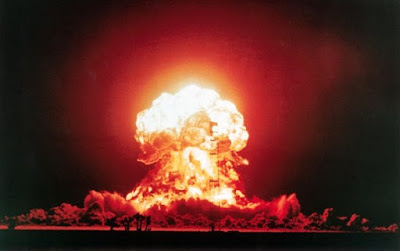 |
| Operation Upshot-Knothole at the Nevada Test Site on April 18, 1953. Credit: Getty Images |
Topics: Biomedicine, Commentary, Existentialism, Nuclear Power, Philosophy
As someone who recalls doing "duck and cover drills," I consider everyday a good day when this is not my sunrise.
The United States is not prepared to deal with the aftermath of a major nuclear attack, despite North Korea’s efforts to develop nuclear weapons and the increasing tensions between nations overall. That was the blunt assessment of public-health experts who participated in a meeting last week on nuclear preparedness, organized by the National Academies of Sciences, Engineering, and Medicine.
The gathering is “an acknowledgement that the threat picture has changed, and that the risk of this happening has gone up”, says Tener Veenema, who studies disaster nursing at Johns Hopkins University in Baltimore, Maryland, and co-chaired the conference in Washington DC.
Since the fall of the Soviet Union in 1991, the United States’s research and preparedness efforts for a nuclear strike have focused largely on the possibility of a terrorist attack with a relatively small, improvised 1-kilotonne weapon or a ‘dirty bomb’ that sprays radioactive material.
But North Korea is thought to have advanced thermonuclear weapons—each more than 180 kilotonnes in size—that would cause many more casualties than would a dirty bomb (see ‘Damage estimates’). “Now that thermonuclear is back on the table, we’re back to people saying, ‘We can’t deal with this,’” says Cham Dallas, a public-health researcher at the University of Georgia in Athens.
U.S. Is Woefully Unprepared for Nuclear Strike, Sarah Reardon, Scientific American
Related link:
10 Chilling Facts About The MAD Doctrine – Mutually Assured Destruction, Joris Nieuwint, War History Online
Comments